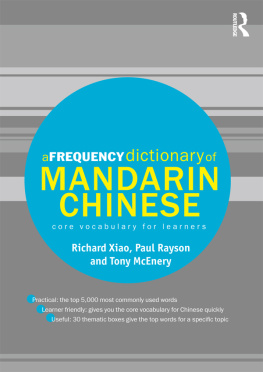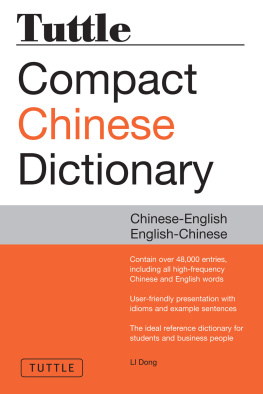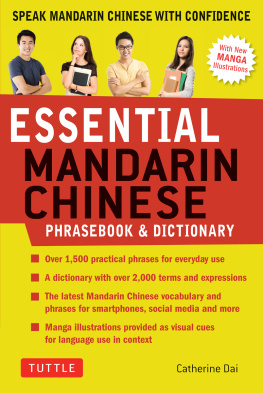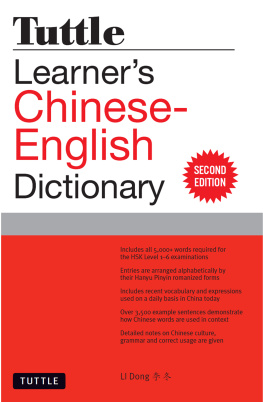A Frequency Dictionary
of Mandarin Chinese A Frequency Dictionary of Mandarin Chinese is an invaluable tool for all learners of Mandarin Chinese, providing a list of the 5,000 words and the 2,000 Chinese characters most commonly used in the language. Based on a 50-million-word corpus composed of spoken, fiction, non-fiction and news texts in current use, the dictionary provides the user with a detailed frequency-based list, as well as alphabetical and part-of-speech indexes. All entries in the frequency list feature the English equivalent and a sample sentence with English translation. The dictionary also contains 30 thematically organised lists of frequently used words on a variety of topics such as food, weather, travel and time expressions. A Frequency Dictionary of Mandarin Chinese enables students of all levels to maximise their study of Mandarin vocabulary in an efficient and engaging way. Richard Xiao is Senior Lecturer and Programme Leader in Chinese Studies at Edge Hill University. Paul Rayson is Director of the University Centre for Computer Corpus Research on Language and a teaching fellow at Lancaster University. Tony McEnery is Professor of English Language and Linguistics at Lancaster University. Routledge Frequency DictionariesGeneral Editors: Paul Rayson, Lancaster University, UK Mark Davies, Brigham Young University, USAEditorial Board: Michael Barlow, University of Auckland, New Zealand Geoffrey Leech, Lancaster University, UK Barbara Lewandowska-Tomaszczyk, University of Lodz, Poland Josef Schmied, Chemnitz University of Technology, Germany Andrew Wilson, Lancaster University, UK Adam Kilgarriff, Lexicography Masterclass Ltd and University of Sussex, UK Hongying Tao, University of California at Los Angeles Chris Tribble, Kings College London, UKOther books in the series:A Frequency Dictionary of GermanA Frequency Dictionary of PortugueseA Frequency Dictionary of SpanishA Frequency Dictionary of French (forthcoming) A Frequency Dictionary of Arabic (forthcoming) First published 2009 by Routledge 2 Park Square, Milton Park, Abingdon, OX14 4RN Simultaneously published in the USA and Canada by Routledge 711 Third Ave, New York, NY 10017 Routledge is an imprint of the Taylor & Francis Group, an informa business 2009 Richard Xiao, Paul Rayson and Tony McEnery Typeset in Parisine by Graphicraft Limited, Hong Kong All rights reserved. Routledge Frequency DictionariesGeneral Editors: Paul Rayson, Lancaster University, UK Mark Davies, Brigham Young University, USAEditorial Board: Michael Barlow, University of Auckland, New Zealand Geoffrey Leech, Lancaster University, UK Barbara Lewandowska-Tomaszczyk, University of Lodz, Poland Josef Schmied, Chemnitz University of Technology, Germany Andrew Wilson, Lancaster University, UK Adam Kilgarriff, Lexicography Masterclass Ltd and University of Sussex, UK Hongying Tao, University of California at Los Angeles Chris Tribble, Kings College London, UKOther books in the series:A Frequency Dictionary of GermanA Frequency Dictionary of PortugueseA Frequency Dictionary of SpanishA Frequency Dictionary of French (forthcoming) A Frequency Dictionary of Arabic (forthcoming) First published 2009 by Routledge 2 Park Square, Milton Park, Abingdon, OX14 4RN Simultaneously published in the USA and Canada by Routledge 711 Third Ave, New York, NY 10017 Routledge is an imprint of the Taylor & Francis Group, an informa business 2009 Richard Xiao, Paul Rayson and Tony McEnery Typeset in Parisine by Graphicraft Limited, Hong Kong All rights reserved.
No part of this book may be reprinted or reproduced or utilised in any form or by any electronic, mechanical, or other means, now known or hereafter invented, including photocopying and recording, or in any information storage or retrieval system, without permission in writing from the publishers. British Library Cataloguing in Publication Data A catalogue record for this book is available from the British Library Library of Congress Cataloging-in-Publication Data Xiao, Richard. A frequency dictionary of Mandarin Chinese : core vocabulary for learners / Richard Xiao, Paul Rayson, Tony McEnery. p. cm. 1. 1.
Chinese languageDictionariesEnglish. I. Rayson, Paul. II. McEnery, Tony, 1964 III. Title.
PL1455.X537 2008 495.1321dc22 2008030172 ISBN: 978-0-415-45586-2 (pbk) ISBN: 978-0-203-88307-5 (ebk)
Contents
Frequency information has a central role to play in learning a language. Nation (1990) showed that the 4,0005,000 most frequent words account for up to 95 per cent of a written text and the 1,000 most frequent words account for 85 per cent of speech. Although Nations results were only for English, they do provide clear evidence that, when employing frequency as a general guide for vocabulary learning, it is possible to acquire a lexicon which will serve a learner well most of the time. There are two caveats to bear in mind here. First, counting words is not as straightforward as it might seem. Gardner (2007) highlights the problems that multiple word meanings, the presence of multiword items, and grouping words into families or lemmas, have on counting and analysing words.
Second, frequency data contained in frequency dictionaries should never act as the only information source to guide a learner. Frequency information is nonetheless a very good starting point, and one which may produce rapid benefits. It therefore seems rational to prioritise learning the words that you are likely to hear and read most often. That is the philosophy behind this series of dictionaries. Lists of words and their frequencies have long been available for teachers and learners of language. For example, Thorndike (1921, 1932) and Thorndike and Lorge (1944) produced word frequency books with counts of word occurrences in texts used in the education of American children.
Michael Wests General Service List of English Words (1953) was primarily aimed at foreign learners of English. More recently, with the aid of efficient computer software and very large bodies of language data (called corpora), researchers have been able to provide more sophisticated frequency counts from both written text and transcribed speech. One important feature of the resulting frequencies presented in this series is that they are derived from recently collected language data. The earlier lists for English included samples from, for example, Austens Pride and Prejudice and Defoes Robinson Crusoe, thus they could no longer represent present-day language in any sense. Frequency data derived from a large representative corpus of a language brings students closer to language as it is used in real life as opposed to textbook language (which often distorts the frequencies of features in a language, see Ljung, 1990). The information in these dictionaries is presented in a number of formats to allow users to access the data in different ways.
So, for example, if you would prefer not to simply drill down through the word frequency list, but would rather focus on verbs for example, the part of speech index will allow you to focus on just the most frequent verbs. Given that verbs typically account for 20 per cent of all words in a language, this may be a good strategy. Also, a focus on function words may be equally rewarding 60 per cent of speech in English is composed of a mere 50 function words. The series also provides information of use to the language teacher. The idea that frequency information may have a role to play in syllabus design is not new (see, for example, Sinclair and Renouf, 1988). However, to date it has been difficult for those teaching languages other than English to use frequency information in syllabus design because of a lack of data.
Next page












